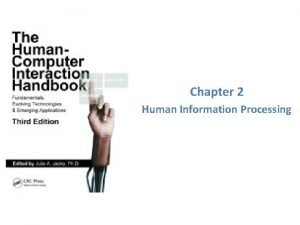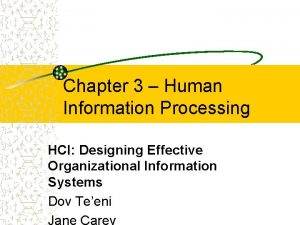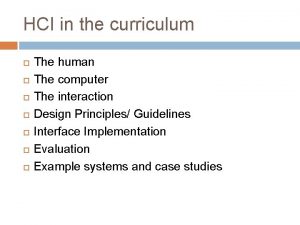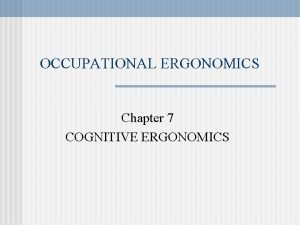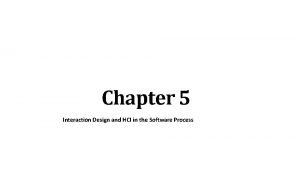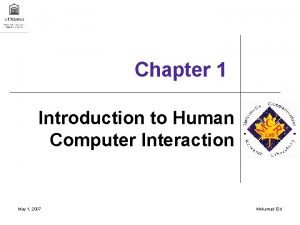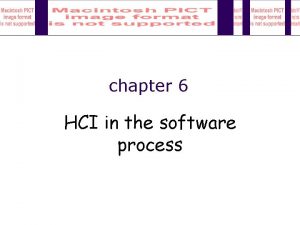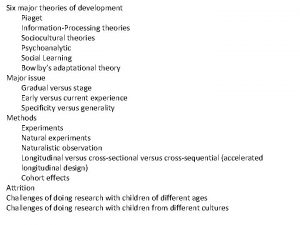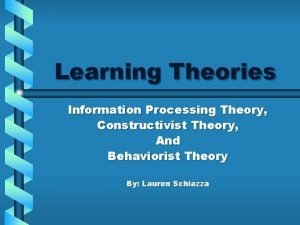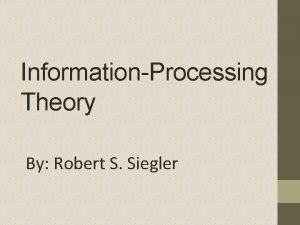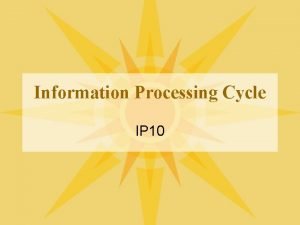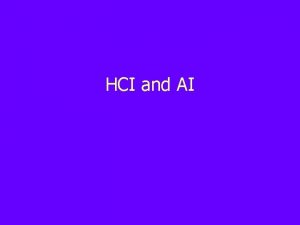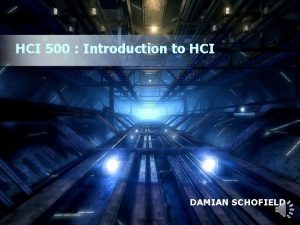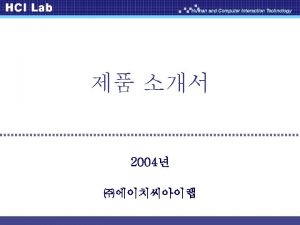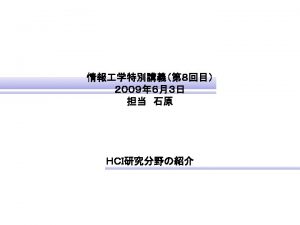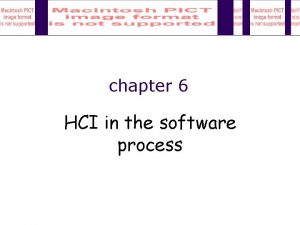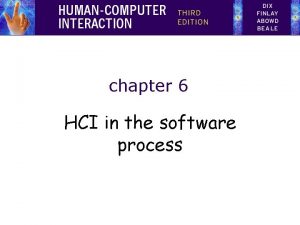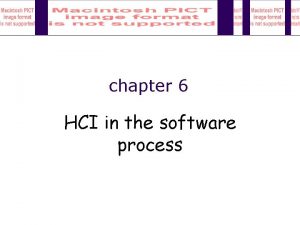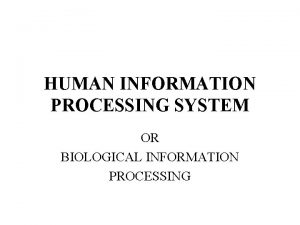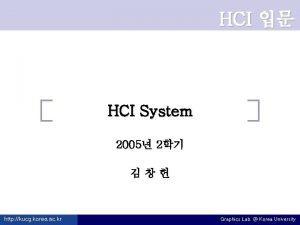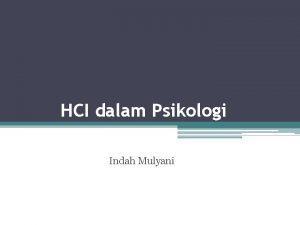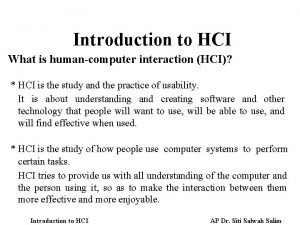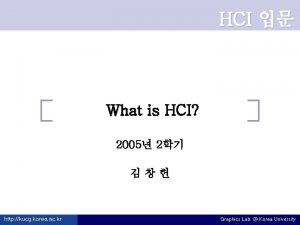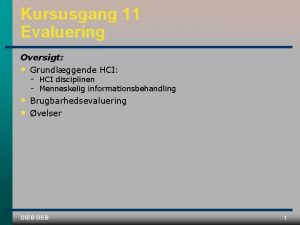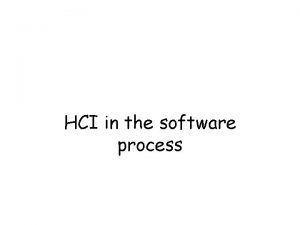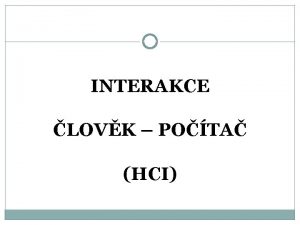Chapter 2 Human Information Processing HCI as a





























- Slides: 29

Chapter 2 Human Information Processing

HCI as a system human computer

Cognitive process

Human information processing

STUDYING HUMAN INFORMATION PROCESSES

Signal detection theory Cognitive model: encoding + decision Evaluation metrics: hit rate false alarm rate (during World War II, British radar observers detected fewer of the enemy’s radar signals after 30 minutes in a radar observation shift)

Reaction Time (RT) • series of discrete processing stages • Subtractive method – selection of tasks that differ by a single stage e. g. compare the time to find a target link on two web pages that are identical except for the number of links displayed

Reaction Time (RT) • series of discrete processing stages • Additive factors method – two variables that affect different stages should have additive effects on RT while two variables that affect the same stage should have interactive effects on RT e. g. mode of icon array (menu or dialog box), number of icons, and difficulty of movement had additive effects on response times

RT vs. accuracy

Neuroergonomics electroencephalograms (EEG) f. MRI

INFORMATION PROCESSING IN CHOICE REACTION TASKS


Mental rotation R R

Response Selection • Hick-Hyman law (N equally likely alternatives): • Compatibility effects – verbal-vocal, spatial-manual Simon-effect: Stroop-effect RIGHT red blue LEFT green yellow

Response Execution • Fitt’s low: D is distance to the target (b is different at various devices) W is target width other factors, e. g. point-click vs. point-drag

PROBLEM SOLVING AND DECISION MAKING

Problem solving • New tasks are frequent at computers • problem space representation – initial and goal states, operations • heuristic path-finding – naive vs. expert

Mental model • based on interaction, the user develops a representation of how the system is functioning for a given task • metaphors – real life (e. g. desktop) – other tasks/systems (e. g. web browsers) • human decision-making heuristics (when the outcome associated with a choice is uncertain) e. g. anchoring heuristic involves making a judgment regarding probabilities of alternative states based on initial information

HUMAN MEMORY IN INFORMATION PROCESSING

Memory refers to explicit recollection of information in the absence of the original stimulus and to persisting effects of that information on information processing that may be implicit. – Episodic vs Semantic memory – Declarative vs procedural • sensory stores, short-term memory (working memory), and long-term memory

short-term memory (STM) • limited capacity • several seconds • 7 ± 2 memory spans • HCI: – distraction (18 sec) – STM load at complex HCI tasks

short-term memory, STM

long-term memory, LTM • shallow vs deep/semantic processing pl. searching for a link on a webpage • generation effect e. g. passwords • mnemonic techniques (ryhme, loci) • false memories

ATTENTION IN INFORMATION PROCESSING

Attention is increased awareness directed at a particular event or action to select it for increased processing. • result in enhanced understanding of the event, improved performance of an action, or better memory for the event • allows to filter out unnecessary information

Attention models • What happens with unattended stimuli? • filter-attenuation theory – early selection by filtering – attenuated signal may be sufficient • late-selection theory – stimuli are identified and later ignored • load theory – When memory load is high, it is not possible to suppress irrelevant information at a cognitive level

Attention and HCI • • multi-task, different modality change blindness attentional blink visual search – menu/icon – feature integration theory • attention demands decrease as a task is practiced

Other cognitive areas in HCI • Task loading and stress • Emotions, mood, sentiment • Motivation and influencing • …

Summary • Cognitive models of human information processing • HCI can be effective if it is compatible with human information processing
 Information processing hci
Information processing hci Information processing hci
Information processing hci Information processing hci
Information processing hci Human information processing model ergonomics
Human information processing model ergonomics What is paradigms in hci
What is paradigms in hci What are input-output channels in hci
What are input-output channels in hci Factors of hci
Factors of hci 8.3 human needs
8.3 human needs Chapter 8 human needs and human development
Chapter 8 human needs and human development Bottom up vs top down processing
Bottom up vs top down processing Gloria suarez
Gloria suarez Bottom up processing
Bottom up processing Neighborhood averaging in image processing
Neighborhood averaging in image processing Secondary processing of food
Secondary processing of food Define point processing
Define point processing Histogram processing in digital image processing
Histogram processing in digital image processing Parallel processing vs concurrent processing
Parallel processing vs concurrent processing Laplacian filter
Laplacian filter Image processing
Image processing Morphological dilation
Morphological dilation Top-down processing
Top-down processing Batch processing vs interactive processing
Batch processing vs interactive processing Hci in software process
Hci in software process Hci chapter 1
Hci chapter 1 It simulate or animate some features of intended system.
It simulate or animate some features of intended system. Vygosky theory
Vygosky theory Constructivist theory
Constructivist theory Cavr audit assertions
Cavr audit assertions What is the information processing theory
What is the information processing theory The information processing cycle
The information processing cycle
